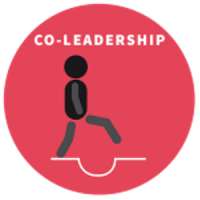Complex, Meidoornkade 22
3992 AE Houten
0343 528 040
3992 AE Houten
0343 528 040

Personal leadership, feeling empowered to take initiative, is one of the key factors for achieving an integrated and sustainable outcome.
The success strategy: Take initiative. We inspire others by example to engage and to interact towards an integrated and sustainable outcome. We can discuss this factor using the following success markers: Feel empowered, Take the lead, Group focus, Social interaction and Generative mindset

Recent surveys show that 34% of the professionals feels empowered but almost the same number feels not. Feeling empowered is a prerequisite for taking the lead and working in a flow. (Source: Ruysdael research on connected leadership)
Empowerment originates from two sources:
Review your inner sources with questions such as:
Review and balance with your external source:
Focus on increasing your circle of influence.
Create clear defintions of tasks, roles and responsibilities for all team members. Balance autonomy among team members in accordance with the level of competence.
Also define and sustain a group responsibility: We, as a team, feel responsible for…
Use methods for :

Who takes the lead when challenging situations require action? In Agile teams there is only one answer to this question: The first person who is aware of it. Especially in complex or dynamic environments it is important to take initiative in order to minimize risks and sustain a natural workflow. (Source: Ruysdael research on connected leadership)
Taking the lead is a form of connected leadership. It is not about function or role. It simply means that you are the first individual taking action in order to anticipate or react to challenging situations, such as uncertainty, risks or issues that block achieving the team objective.
Three competences are a prerequisite for taking the lead: calm alertness, forward thinking and swift deliberate action.
This requires overview (who, what/when), insight (what is the proper action) and a clear line of sight (objective and blocking issues).
Make sure all team members share a common view on the next steps, interdependencies and cohesion of the deliverables of the group.
Know your communication and decision flow
Stimulate ‘pacing en leading’ and communicate that this a part of the group culture.
Use the a2Results® Team app at regular interval and discusss team development.
Stimulate transparancy, interaction and openness.

Most teams struggle with obtaining a group focus. There are at least two important blockers: In most cases it boils down to different perceptions about the results, the importance of certain tasks and the workflow. Another blocker is the personal need or desire to work autonomously. (Source: Ruysdael research on connected leadership)

Success is a joint effort and social interaction is the key. 29% of the professionals in this survey feel this interaction is stimulated in teams and 25% feels it is not. Many seem to prefer single autonomous work above alignment en interaction. In dynamic, multidisciplinary or complex environments however social interaction is a prerequisite for team synergy and agility. (Source: Ruysdael research on connected leadership)
An egocentric approach to the day to day work challenges might not stimulate social interaction. Interaction starts with a centered open mind and the ability to connect to perception and feelings of others. It is easier to stimulate positive interaction when you find time to connect with others and work with a mindset of interdependency. Finding and organizing the right time and place is one of the stimulating factors.
Awareness questions:
Use methods for:

A generative mindset creates more possibilities than one single person can imagine. Sustainable succes is the result of people that are driven to align their inspiration and ambition into a collectieve mindset. 45% of the professionals in the survey feels that team members lack the commitment to do so. In settings which need creativity or problem solving capabilities a collective mindset might spark when team members built on each other and try to find the common ground that embraces the differences. (Source: Ruysdael research on connected leadership)v
Create your personal conditions for a generative mindset:
Rien van Leeuwen gaat in op basiscondities voor duurzame verandering.
Aan de hand van praktijk-cases verkennen we de barrières bij het bereiken van duurzame doelen op strategisch, tactisch en operationeel niveau. Denk hierbij aan bestaande structuren en opvattingen, maar ook aan het niet kunnen duiden van negatieve en positieve impact.
We delen onderling de best practices en interventies die anderen activeren. Uiteindelijk draait elke verandering om een andere manier van interactie.
Rien van Leeuwen gaat in op basiscondities voor duurzame verandering.
Aan de hand van praktijk-cases verkennen we de barrières bij het bereiken van duurzame doelen op strategisch, tactisch en operationeel niveau. Denk hierbij aan bestaande structuren en opvattingen, maar ook aan het niet kunnen duiden van negatieve en positieve impact.
We delen onderling de best practices en interventies die anderen activeren. Uiteindelijk draait elke verandering om een andere manier van interactie.